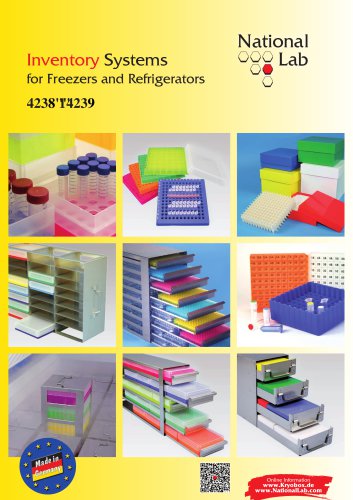 Website:
Frisenette ApS
Website:
Frisenette ApS
Catalog excerpts

Laboratory Filtration Products
Open the catalog to page 1
We are proud to present this second issue of a European catalogue of ADVANTEC® products manufactured by Toyo Roshi Kaisha, Ltd. Toyo Roshi Kaisha, Ltd. is a well-reputed, leading manufacturer of filtration media and related scientific products, which was founded in 1917. To date, the company’s main markets have been Japan, Asia and the United States. Since 2004 the range of laboratory filtration products and related equipment also has been available in Europe. Our mission is to supply the pharmaceutical, public health, life science, chemical industry, food and beverage industry,...
Open the catalog to page 2
Membrane Filters Petri Dishes and Pads Syringe Filters Ultra Filtration Units Glass- and Quartz Fiber Filters Composite Filters Filter Papers Milk Sediment Discs Paper Discs PTFE Depth Filters Extraction Thimbles Blotting Membranes and -Papers Vacuum Filter Holders Filtration Manifolds Pressure Filtration Capsule Filters Monitors Test Papers Chemical Compatability Guide Index – A-Z Index – Catalogue Nos
Open the catalog to page 3
Membrane filters or membranes are micro-porous plastic films with specific pore size ratings. Also known as screen, sieve or microporous filters, membranes retain particles or microorganisms larger than their pore size primarily by surface capture. Some particles smaller than the stated pore size may be retained by other mechanisms. Advantec membranes are produced by three different processes. Mixed Cellulose Ester and Cellulose Acetate are reverse phase solvent cast membranes, where controlled evaporation or removal of the complex solvent system forms the porous structure. Both hydrophilic...
Open the catalog to page 4
Membrane Sample General polymer applications compatibility Pore size range available [pm' 10 Mixed Cellulose Ester (MCE) General purpose Microbiology Particle analysis Aqueous solutions Cellulose Acetate General filtration Cytology Binding studies Aqueous solutions Coated Cellulose Acetate Clarify solutions Aqueous Prefilter solutions Hydrophilic PTFE HPLC solutions Clarify or sterilize aqueous/organic mixturesAqueous and organic solutions Hydrophobic PTFE Gas venting Clarify or sterilize strong Non-aqueous solvents acids or solvents Microscopy Polycarbonate...
Open the catalog to page 5
Mixed Cellulose Esters (MCE) • Composition: Mixed cellulose esters includes cellulose nitrate, also known as nitrocellulose, and cellulose acetate • High porosity: Provides superior flow rates • High protein binding: Can be blocked by pretreatment or utilized in applications • High purity: Triton-free and non reactive to pyrogens • Autoclavable: Withstands autoclaving temperatures up to 130°C without adversely affecting bubble point, flow rate or microbiological recovery • Rapid wetting time: < 3 seconds to wet a 47 mm diameter disc with aqueous 1% methylene blue Applications • Standard...
Open the catalog to page 6
White - Non-sterile White - Non-sterile (continued) Pore Size [Mm] *with hydrophobic edge
Open the catalog to page 7
Black - Non-sterile Opticlear - Non-sterile (continued) Pore Size [Mm] Green - Non-sterile Pore Size [Mm]
Open the catalog to page 8
Ash Content of Cellulose Acetate Cellulose Acetate (CA) • Composition: Mixture of cellulose triacetate and diacetate • Characteristics: Low static charge and high strength • Sterilizable: May be repeatedly sterilized without loss of integrity or change in bubble point • Clean: 0.1wt% aqueous extractables • Relative to MCE membranes: - improved solvent resistance to low molecular weight alcohols - better heat resistance - lower protein binding Applications • Enhanced recovery of fastidious gram positive organisms • Filtration of enzyme solutions • Diagnostic cytology • Receptor binding studies
Open the catalog to page 9
Coated Cellulose Acetate • Composition: Cellulose acetate cast onto a non-woven polyester support • Characteristics: Non-fiber releasing • Low protein binding relative to nitrocellulose • Low static charge matrix with enhanced chemical compatibility to low molecular weight alcohols • Use as a clarifying filter or prefilter Specifications for Coated Cellulose Acetate, Code Y Nominal Rating [pm] Definitions 1. Bubble point is the minimum pressure required to force air through a membrane which has been prewet with water 2. Flow Rates indicates initial flow rate at 10 psi using a KGS 47...
Open the catalog to page 10
Hydrophilic PTFE • Characteristics: Maximum chemical and pH resistance • High flow rates with minimal aqueous extractables (<0.3 wt%) • Optically clear when wet with water • Non-supported Applications • Ideal for HPLC and other mixtures of aqueous and organic solvents Note: Autoclaving is not recommended since the membrane then will be hydrophobic. Specifications for hydrophilic PTFE, Code H Trace Metal Content [ppm]
Open the catalog to page 11
Hydrophobic PTFE, supported • Properties: Thin, highly porous, behaves as an absolute retentive membrane • Supported: Polypropylene laminated to one side to improve handling • Inert to most chemically aggressive solvents, strong acids and bases • Thermostable: Can be used up to 130°C Applications • Sterilize gases: Traps aqueous aerosols • Air and gas venting: Allows gases to pass freely while blocking aqueous liquids, protect vacuum pumps and critical samples • Sterilize and clarify strong acids and many other solvents incompatible with other membrane types Specifications for hydrophobic...
Open the catalog to page 12
Hydrophobic PTFE, unsupported • Properties: Thin, highly porous, behaves as an absolute retentive membrane • Inert to most chemically aggressive solvents, strong acids and bases • Operating Temperature Range: 120 - 260°C Applications • Sterilize gases. Traps aqueous aerosols • Air and gas venting: Allows gases to pass freely while blocking aqueous liquids, protect vacuum pumps and critical samples • Sterilize and clarify strong acids and many other solvents incompatible with other membranes Trace Metal Content [pg/g] Al Ca Cr Cu Ordering Information Pore Size [Mm]
Open the catalog to page 13All Frisenette ApS catalogs and technical brochures
-
Cleanroom
236 Pages
-
Laboratory Filtration Products
97 Pages
-
Vials and caps 2017
68 Pages
-
Medical and Laboratory Supplies
216 Pages
-
frisenette-labsupplies
316 Pages
-
VISOCOLOR® Fish
1 Pages










